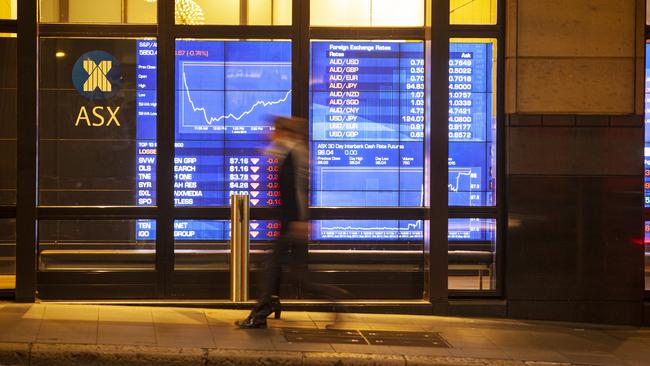If the market has recovered, then why aren’t you bargain hunting?
A ‘most distrusted’ sharemarket rally has come to a halt thanks to a reversal that some key players think hasn’t been severe enough.

If the share market reversal is over, investors should obviously be bargain hunting right?
Well, they’re not.
Certainly not on the Australian market where we are now sitting on a grand total return for the year of less than 2 per cent.
Instead, we are back staring at what Danielle Ecuyer in the latest Money Puzzle podcast describes as “a most distrusted sharemarket rally”.
Unless you are a very inexperienced investor, the big takeaway after last Monday’s session – which saw the worst one-day drop in four years – is that nobody could offer a convincing explanation as to why it happened.
When markets fall “for no reason” it means another big drop may not be far away; Mr Market is literally looking for a reason to sell off again.
It was nothing short of light entertainment to hear market pundits explain why the sharemarket dropped so swiftly.
The most feasible explanation was that the US may be facing a recession, but that is only a one in five chance – and a single jobs report triggered the fear.
After that, the explanations get ever more exotic. Warren Buffett spooked traders because he sold half of his Apple shares, Nvidia has run too hot, the Japanese carry trade is unwinding.
Any of those factors could be viewed as negative but they do not justify what happened when traders lost their nerve and indiscriminate selling took hold for a few hours.
Some sharemarket reversals have a clear explanation. For instance in 2020 it was the Covid-19 pandemic.
But it is not always so simple. The trigger for one of the greatest stock market crashes in 1987 was very much a mystery at the time,
There were a string of alleged explanations, but in reality the market needed to reset because it had become completely overpriced. Stocks fell 20 per cent in a single day on Black Tuesday.
As James Mackintosh of the Wall Street Journal says: “Just as today, in 1987 investors were on edge and ready to sell to lock in the unexpected profit.
“The losses are smaller so far, but lucrative trades have reversed, just as they did for the market as a whole in 1987.”
Nonetheless, mini- pullbacks offer very useful signals. The ASX fell hard when the selling wave started. Moreover, it has not recovered this week at the same pace as Wall Street.
The scare also revealed how, in the absence of the real thing, we have been anointing certain shares as “AI bets”. That’s why Goodman Group – a real estate investment trust – was one of the hardest hit stocks last week. It has become a proxy for the AI boom.
If you have to listen to someone prognosticate about the market, the best people are those at the heart of the action, which in this case are the strategists at the major US investment banks.
Many of them are saying this week’s drop was not big enough. They are implicitly suggesting another, and harder, sell-off is not far away. (Historically, September and October are the months we get the serious reversals).
Morgan Stanley chief investment officer Mike Wilson is the guru here. As we know, the 20-year average price earnings ratio on the S&P 500 is 16 times, but it
recently rose as high as 22 times.
“If earnings revisions continue to fade, as the seasonal trends suggest, it’s likely these valuations have further to fall,” Wilson says.
“With our 12-month base case target multiple at 19 times, the risk-reward for equities broadly remains unfavourable.”
Sobering stuff, and certainly not an argument for bargain hunting.
However, the ASX is not Wall Street. We don’t have the mega caps or serious AI player, but we do offer big dividends compared with US stocks.
In effect, this is the value proposal: Relatively mediocre price increases cushioned by solid dividend returns.
But a looming problem for local investors is that, on top of the risk that this highly volatile sharemarket will fall again, the dividend yield promise on the ASX is weakening.
The outlook for the dividend yield in the market is now below 4 per cent.
As Cameron Gleeson of Betashares told The Australian earlier this week, the forecast dividend yield for the wider market is now at 3.8 per cent, which is a level we only see during recessions.
Weakening dividend payouts are largely due to the weakening conditions for miners. In turn this leaves it to big bank stocks to carry our market this year.
Commonwealth Bank, the “dividend influencer”, reports on Wednesday and the market expects a lower profit but a higher dividend.
Local market strategists such as David Cassidy of Wilsons Advisory continue to offer a sanguine reading of the market blow-off.
“Some of the moves looks overdone. Investors should be on the hunt for some opportunities here,” Cassidy says.
Meanwhile, brokers at Bell Potter have been tossing out ideas such as Aristocrat Leisure, ARB, Flight Centre and Wisetech. Looking offshore, Macquarie’s thematic winners include Nvidia and Microsoft.
Bargain hunt if you want. Stocks are cheaper than they were this time last week.
Your biggest risk is that shares could be even cheaper later in the year if key US strategists have it right and this week’s drop was simply not enough.
James Kirby hosts the twice weekly Money Puzzle podcast






To join the conversation, please log in. Don't have an account? Register
Join the conversation, you are commenting as Logout